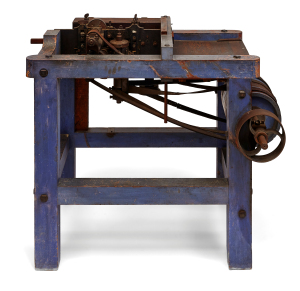
Swift Slat Planer, Church Family, Hancock, MA , Shaker Museum | Mount Lebanon, 1958.10733.1, Matthew Kroening, photographer.
Beginning in the 1840s and continuing into the 1870s, the Shakers at Hancock manufactured expandable/collapsible yarn swifts for sale. Among other occasional uses, swifts processed skeins of yarn into balls for knitting or crocheting. A knitter faced with this task could ask someone to spread his or her arms and hold the looped skein as it […]

Swift Slat Planer, Church Family, Hancock, MA , Shaker Museum | Mount Lebanon, 1958.10733.1, Matthew Kroening, photographer.
Beginning in the 1840s and continuing into the 1870s, the Shakers at Hancock manufactured expandable/collapsible yarn swifts for sale. Among other occasional uses, swifts processed skeins of yarn into balls for knitting or crocheting. A knitter faced with this task could ask someone to spread his or her arms and hold the looped skein as it was slowly wound off into a ball, or lacking a willing assistant, could place the skein over the slats of a swift, expand its slats (much like opening an umbrella), and, with the skein held securely, wind a ball of yarn without help.
It appears that, like oval box making in other Shaker communities, at Hancock swift-making fell to the community elders as it was work that could easily be put aside when their administrative duties took precedent. Elders Grove Wright (1789-1861) and Thomas Damon (1819-1880) are the two names associated with Hancock’s swift business and both are known to have been accomplished woodworkers. The number of swifts made by one or both of these two brothers averaged over 900 pairs per year between 1854 and 1860.

Swift Slats, Church Family, Hancock, Massachusetts, ca. 1860s, Shaker Museum | Mount Lebanon, 2012.11.3-.41
All of the pieces necessary for assembling a swift were turned on a lathe with the exception of the slats that held the yarn. Each swift required one or two of each of the turned pieces, but required twenty-four slats for the swift to be completed. Producing nine hundred swifts required over 21,000 slats. That arduous task apparently set Elder Thomas on the road to making a machine that would lighten this burden. His solution was to design and build a machine that took a rough-sawn piece of wood, smoothed its flat sides, made it the required thickness and width, and slightly rounded its edges – all with a single pass through the machine. His planning and construction of this machine paid off, for on October 10, 1854, he recorded in his diary that he, “Started a new machine for planing & edging Swift slats, it worked charmingly and bid fair to be the ‘Ne plus ultra’ in that line.” The remaining work of preparing the slats was relatively easy. Once the ends were rounded and it had holes drilled in it, it was ready for assembly. While we do not have production statistics for swifts made in years prior to 1854, when this machine was put in service, it is likely that the number greatly increased.

Swift Slat Planer, Church Family, Hancock, MA , Shaker Museum | Mount Lebanon, 1958.10733.1, Matthew Kroening, photographer.
In the woodworking industry, machines similar to Elder Thomas’s machine are called four-sided molding machines and are commonly used to make decorative moldings for houses and furniture. The Shakers’ four-sided molding machine was purchased by the Shaker Museum|Mount Lebanon from the Hancock Shakers’ workshops in 1958.